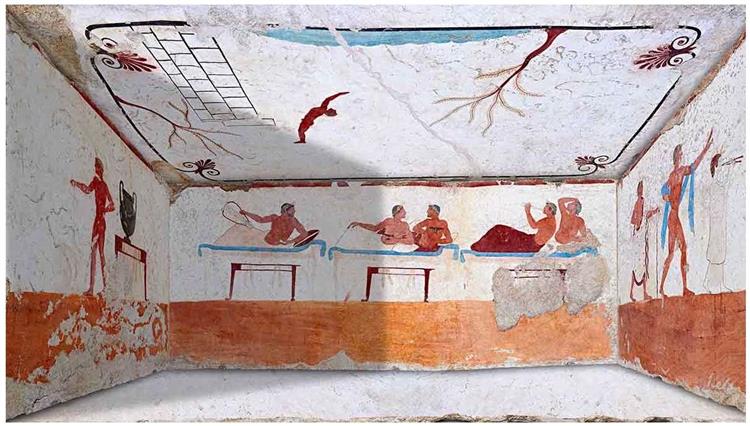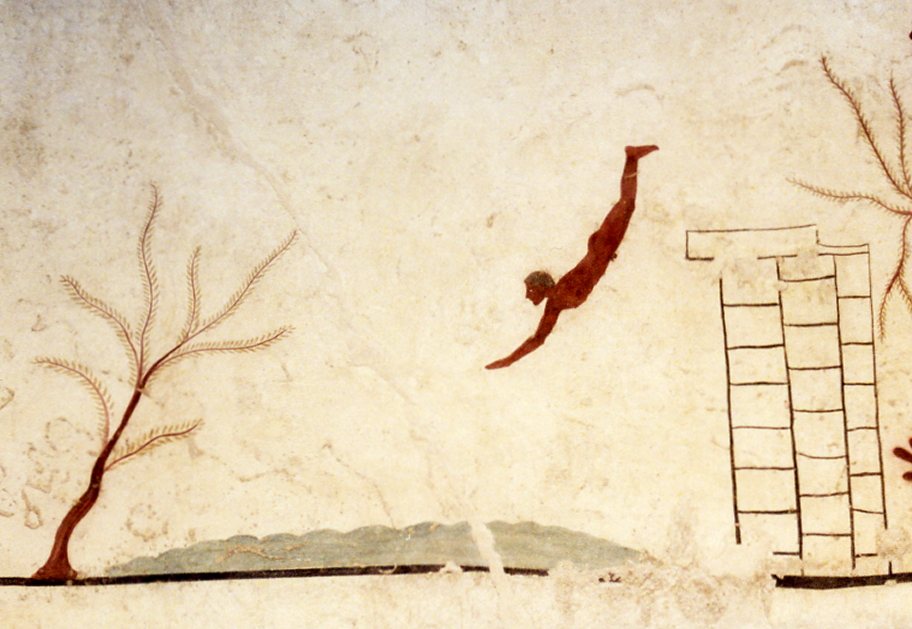The Tomb of the Diver, dating back to approximately 470 BCE, is an exceptional archaeological discovery near Paestum, southern Italy. Unlike typical Greek funerary monuments, which often featured sculpted reliefs or were left undecorated, this tomb stands out due to its remarkably preserved frescoes. These paintings provide a rare glimpse into Greek funerary customs and artistic traditions, making the tomb a unique artifact from the Archaic to early Classical period.

Structure and Construction
The tomb is composed of five large limestone slabs, forming four vertical walls and a ceiling, while the floor was directly carved into the natural bedrock. The slabs were carefully fitted together and sealed with plaster, ensuring the preservation of the artwork inside.
One of the most remarkable aspects of the tomb is its true fresco technique, in which pigments were applied onto wet plaster. This allowed the colors to chemically bond with the wall as it dried, resulting in the vivid and long-lasting frescoes that still survive today.
Symbolism of the Frescoes
The Symposium Scenes (Side Walls)
The four lateral walls are adorned with symposium (banquet) scenes, a central aspect of elite Greek culture. These images depict:
- Reclining figures drinking wine, likely participants of a symposium.
- Attendants serving guests, emphasizing hospitality.
- Musicians and entertainers, showcasing the lively nature of these gatherings.
The symposium was more than just a social event—it symbolized intellectual exchange, pleasure, and philosophical discussions. Its presence in the tomb suggests a belief in the continuation of these pleasures in the afterlife.

The Diving Figure (Ceiling Panel)
The ceiling panel presents the most enigmatic image: a solitary figure diving into water. This fresco has intrigued scholars for decades, with interpretations including:
- A metaphor for the transition from life to death.
- The soul’s journey into the afterlife, a concept similar to later philosophical and religious beliefs.
- A symbol of renewal and rebirth, echoing themes in Greek thought.
The uniqueness of this motif within Greek art sets the Tomb of the Diver apart from any other known burial site of the period.

Historical Context and Discovery
The tomb was discovered in 1968 by Italian archaeologist Mario Napoli, who recognized its unparalleled significance. Unlike the Etruscans or Egyptians, who often decorated their tombs with elaborate frescoes, the Greeks of this period rarely painted their burial chambers.
This discovery challenges traditional assumptions about Greek funerary customs, offering new insights into:
- Beliefs about death and the afterlife in the Greek world.
- The role of symposium culture in aristocratic life.
- The artistic techniques and influences of Greek painters.
Today, the Tomb of the Diver is preserved in the Paestum Archaeological Museum, where visitors can witness its stunning frescoes firsthand.
The Significance of the Tomb of the Diver
The tomb remains one of the most intriguing archaeological finds of the 20th century. It not only enriches our understanding of Greek funerary practices but also serves as a rare example of Classical Greek painting, as very few such artworks have survived to the present day.
Its discovery continues to inspire discussions among historians, archaeologists, and art scholars, cementing its place as a mystical and thought-provoking artifact of ancient Greece.
Conclusion
The Tomb of the Diver is far more than a burial site—it is a window into the beliefs, rituals, and artistry of ancient Greece. With its vivid frescoes and profound symbolism, it challenges preconceived notions about Greek funerary traditions and offers a compelling glimpse into the mystery of life, death, and the afterlife in the classical world.
